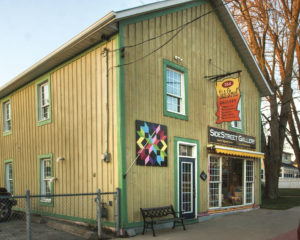Comment
What could be
Marjorie Wiltse knows the debate well. She’s heard it all before. In nine decades living in Wellington, Marjorie has documented the changing face of the village. Each week she shares with Times’ readers an image retrieved from her personal archives that tells a story about what the village was and about the people who built it. This legacy is important to her.
Two decades have passed since Marjorie last immersed herself in the fight to save an important piece of the village’s streetscape; the Orange Lodge on Wellington’s Main Street.
Like the convenience store, the Orange Hall (as it was known, long after the Orangemen had vacated it) was considered an eyesore. The village owned the building and had allowed it to fall into disrepair. In 1996 village officials decided it was beyond recovery, and should be demolished. The community, represented by folks including Marjorie Wiltse, Ernie Margetson and Pat and Roger Whittaker, rallied in support of preserving the building.
Today, it is a wonderfully restored and proud structure that serves as home to SideStreet Gallery. It is hard to imagine Main Street without its presence.
Yet just 21 years ago, it was just another old, derelict building. Beyond redemption. Like the convenience store, the Orange Lodge was perched on a wobbly foundation. Nevertheless, it had endured a century and a third—of winters, wind and floods.
 The village council was eager to accommodate the meat plant and the jobs it provided. It had earlier approved the destruction of the Pearsall home (between East and Main Bistro and Sidestreet Gallery) to enable easier truck access to the plant. Wrecking the Orange lodge would make way for expanded parking.
The village council was eager to accommodate the meat plant and the jobs it provided. It had earlier approved the destruction of the Pearsall home (between East and Main Bistro and Sidestreet Gallery) to enable easier truck access to the plant. Wrecking the Orange lodge would make way for expanded parking.
So, in March 1997 the village council approved demolition. The pushback was immediate. Wellington residents had had enough of the gutting of main street for the ambitions of a single business.
Council relented, staying demolition until August, to allow time to hear other proposals.
Marjorie Wiltse amassed documents, photographs and images that told the story of the building. She prepared a presentation to council that described the buildings’ origins, its inhabitants, the role it played in the life of the village. Finally, she made a plea for it to be preserved.
James Thompson Lane (for whom Lane Creek is named) owned much of the core of the village, in the mid 19th century. In 1861, he sold four square rods of land to a pair of merchants and a carriage maker for $50. As trustees of the not-yet-formed-village-councilthey planned a public building that would accommodate council meetings, court sessions, public meetings and gatherings of the Society of Orangemen.
According to Marjorie’s research, the building was constructed to coincide with the incorporation of the village in 1862. It served as the village’s town hall until 1922 when the Wellington Consolidated School was built, leaving vacant the building beside St. Andrew’s Anglican Church.
Over its life, the building also served as a jail, a fire hall and storage for the Wellington Hydro-Electric Commission. In the early part of the last century it hosted meetings of the anti-smoking fraternity that arose against the ingestion of tobacco smoke.
In its presentation to the village council in the spring of 1997, the Orange Lodge Preservation Committee made three recommendations. 1. Don’t demolish the building for a parking lot. 2. Sell the property by way of a public tender to a private interest. 3. Work with the committee to prepare tender documents. 4. Erect a plaque that expresses the history and former uses of the building.
In their conclusion, the committee of residents pointed to a viable future for the building.
“It is felt that this future would best be served [by selling] the building to a private interest such that there is an incentive to renew its appearance and role. If renewed for a new use, the building could certainly exist for another 135 years.”
That view took imagination in 1997. Courage.
The village council accepted the committee’s recommendations. Felix Liebregts purchased the building from the village. He restored it and brought it back to life as a vital commercial node on Main Street.
It is strange to think, now, that this interesting and attractive building with its compelling history was days away from being levelled to the ground.
Yet this is the fate that continues to hang over the convenience store. To those who believe it has no value, or is unworthy of preservation, imagine Main Street without the SideStreet Gallery building—explain how a larger parking lot would be an improvement to the village streetscape.
This same opportunity exists for the convenience store. It needs no additional investment by the municipality— just the courage to see what could be. And the willingness to return it to private hands.
Oh, and let’s put a plaque on the former Orange Hall building. Its seems overdue.

Comments (0)